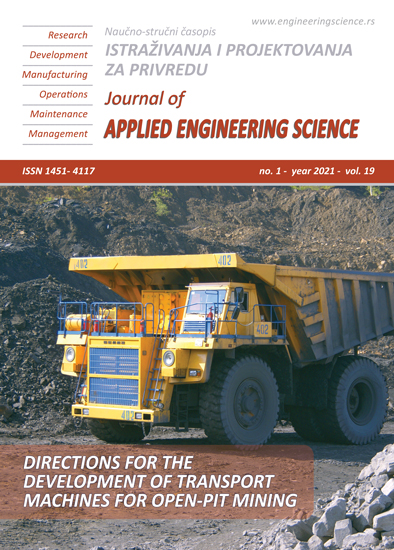MODELING OF THE PROCESS OF COLLECTION, SORTING AND TRANSPORTATION OF LOGGING RESIDUES AT THE LOGGING AREA
Abstract
Effectiveness of economic development of logging industry is impossible without scientifically grounded strategies of formation of perspective technological logging processes with complex use of the total biomass of harvested trees. Degree of utilization of wood biomass is to be considered the most important principle of progressive logging technology. One of the main tasks of the national logging complex is the use of low-grade wood, lumpy wood waste, top of trees, twigs and branches, which will significantly improve efficiency of logging. To solve this problem, this article reviews the process of modeling of work of sorting and transportation machine designed for loading, sorting and transportation of felling residues to timber road. The technological scheme also provides cutting waste with knife for sorting by size. The study provides a detailed technological scheme of logging operations using forwarders with a removable body for loading, sorting and transportation of felling residues. The body of the forwarder is divided into compartments for transportation of waste with different parameters. The information and logical model of the process of collection, sorting and transportation of felling residue, which is proposed by machine, was offered. The formula for calculating the performance of operation of the sorting and transportation machine was obtained. Sorting according to species and types of felling residues is necessary for the production of fuel and technological wood chips for further use in production of valuable commercial products.
References
Bezrukih Yu. A., Medvedev S. O., Alashkevich Yu. D., Mokhirev A. P. (2014). Rational nature resource management in the conditions of sustainable development of the economy of industrial enterprises of the timber complex. Economics and Enterprise. No. 12-2. pp. 994-996.
Mokhirev P. A., Zyryanov M., Ryabova G. T., Vititnev A. (2019). Evaluation of possi-bility of obtaining woodchips from wood residues. Journal of Applied Engineering Science, 17(2). pp. 140-143.
Vasiliev S. B., Piatkin V. I., Shegelman I. R. (2001). Technique and technology for production of chips in the timber industry: monograph. - Petrozavodsk: Publ. by Petrozavodsk State University. P. 100.
Gerasimov Y., Senko S., T. Karjalainen (2013). Nordic forest energy solutions in the Republic of Karelia. Forests. No. 4. 945-967.
Kärhä K. (2007). Production and Use of Wood Chips: Improving Supply Chains. Wood Energy UNECE/FAO Workshop, Belgrade, Serbia. р. 68.
Heikkilä J., Tanttu J. V., Lindblad J., Sirén M., Asikainen A. (2006). Harvesting alternatives and cost factors of delimbed energy wood Metsanduslikud Laitila, Uurimused - Forestry Studies. No. 45. 49-56.
T. Karjalainen, A. Asikainen, J. Ilavsky, R. Zamboni, K-E. Hotari, D. Röser (2004). Estimation of Energy Wood Potential in Europe. Working Papers of the Finnish Forest Research Institute. 43.
Shchukin P. O. Demchuk A. V., Budnik P. V. (2012). Improvement of the efficiency of processing of secondary logging resources for fuel chips. Engineering Bulletin of Don. No. 3. URL: http://ivdon.ru/magazine/archive/n3y2012/1025.
Väätäinen K. (2007). Wood fuel procurement methods and logistics in Finland. Wood fuel production for small scale use. University Eberswalde. Р. 28.
Mokhirev A.P., Bezrukih Yu.A., Medvedev S.O. (2015). Recycling of wood waste from timber enterprises as a factor in sustainable nature recourses management. Engineering Bulletin of Don. Vol. 36. No. 2-2. С. 81. URL: http://www.ivdon.ru/ru/magazine/archive/n2p2y2015/3011.
Medvedev S.O., Bezrukih Yu.A., Mokhirev A.P. (2015). Theoretical aspects of recycling of wood waste from the timber industry. Actual directions of scientific research of the XXI century: theory and practice. Vol. 3. No. 9-2 (20-2). 209-213. DOI: 10.12737/16468
Heift R. (2000). Wykorzystanie odpadow pochadzenia roslirmego do celow energetycznych. Recuklace odpadu TV, VSB TU Ostrava. 165 - 173.
Mohirev A.P., Zyryanov M. A. (2015). The technology of logging operations with sorting of logging residuals. Systems. Methods. Technology. No. 3. 118-122.
Mokhirev A. P., Mammatov V. O., Urazaev A. P. (2015). Modeling of the technological process of work of logging machines. International Scientific Research. No. 3 (24). 72-74.
Sukhanov Yu. V., Gerasimov Yu. Yu., Seliverstov A. A., Sokolov A. P. (2011). Technological chains and systems of machines for collecting and recycling of wood biomass into fuel chips during continuous logging in assortments. Systems. Methods Technology. No. 4. 101-107.
Smirnov M., Shirnin Y., Shirnin A., Andrianov Y. (2019) Research into the process of loading wood assortments by a tractor-mounted hydraulic manipulator of a tractor-trailer train. Journal of Applied Engineering Science. Vol. 17. No. 3. 373-378. DOI: 10.5937/jaes17-20745
Mokhirev A. P. (2016). Modeling of the process of operation of the machine for sorting and transportation of logging residues at the logging area. System. Methods. Technology. No. 1 (29). P. 89-94. DOI: 10.18324/2077-5415-2016-1-89-94
Rukomoynikov K. P. (2013). Simulation modelling of mutually agreed work of sets of adaptive modular timber machines. Bulletin of the MSFU “Forest Bulletin”. No. 3 (95). P. 154-159.

